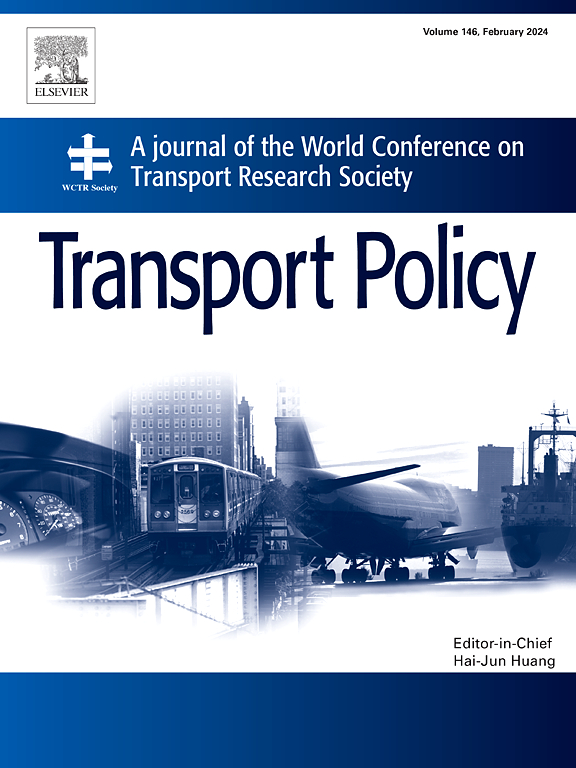A framework for modal split and implications on transport growth and travel time savings
IF 6.3
2区 工程技术
Q1 ECONOMICS
引用次数: 0
Abstract
Mobility is one of the most debated issues in the current discussion on transport policies and the climate change. Related indicators are the modal split, transport growth and travel time savings, used for travel behaviour evaluations. In official transport statistics, the modal split is generally used in two ways, according to the number of modal trips and to the modal trip length. Although they are usually used separately, we will show that they are directly connected, where the latter is a weighted version of the former. The introduction of the reference units of “person” and “day” overcomes the limitations of a trip-based definition and extends the ansatz to a mobility-based methodology, where all modal combinations can be considered. Empirical data analysis shows, that transport growth is founded on the increase of individual motorised transport at the disadvantage of pedestrians, whereas other modes remain fairly stable. Daily travel time generally increases especially with individual motorised transport in comparison to non-motorised modes, which shows an inconsistency, for example, for some assumptions or approaches of travel time savings. The proposed methodology does not require any prior assumptions and provides therefore a simple and general applicability. The data analysis is based on national travel survey data from Germany, Switzerland, UK and USA from the 1970-ies up to 2018. One main result of the paper is a frame of reference for the relativity of mobility behaviour, which consistently connects these mobility indicators.
交通模式划分框架及其对运输增长和旅行时间节省的影响
在当前有关交通政策和气候变化的讨论中,流动性是争论最多的问题之一。相关指标包括模式分配、交通增长和旅行时间节省,用于旅行行为评估。在官方交通统计中,模式划分通常有两种使用方式,一种是根据模式出行次数,另一种是根据模式出行长度。虽然这两种方式通常是分开使用的,但我们将说明它们之间存在直接联系,后者是前者的加权版本。人 "和 "日 "参考单位的引入克服了基于出行的定义的局限性,并将反演扩展为基于流动性的方法,在这种方法中可以考虑所有模式组合。经验数据分析显示,交通增长的基础是个体机动交通的增加,这不利于行人,而其他交通方式则保持相当稳定。与非机动化交通方式相比,个体机动化交通方式的每日出行时间普遍增加,这表明某些假设或节约出行时间的方法并不一致。建议的方法不需要任何预先假设,因此具有简单和普遍的适用性。数据分析基于德国、瑞士、英国和美国从 1970 年代到 2018 年的全国出行调查数据。本文的一个主要成果是为流动行为的相对性提供了一个参考框架,该框架将这些流动性指标联系在一起。
本文章由计算机程序翻译,如有差异,请以英文原文为准。
求助全文
约1分钟内获得全文
求助全文
来源期刊

Transport Policy
Multiple-
CiteScore
12.10
自引率
10.30%
发文量
282
期刊介绍:
Transport Policy is an international journal aimed at bridging the gap between theory and practice in transport. Its subject areas reflect the concerns of policymakers in government, industry, voluntary organisations and the public at large, providing independent, original and rigorous analysis to understand how policy decisions have been taken, monitor their effects, and suggest how they may be improved. The journal treats the transport sector comprehensively, and in the context of other sectors including energy, housing, industry and planning. All modes are covered: land, sea and air; road and rail; public and private; motorised and non-motorised; passenger and freight.
 求助内容:
求助内容: 应助结果提醒方式:
应助结果提醒方式:


